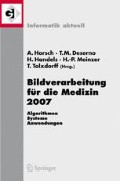Zusammenfassung
Wir stellen eine neuartige Methode zur Segmentierung volumetrischer Bilddaten vor, die Techniken von statistischen Formmodellen mit deformierbaren Oberflächen kombiniert. Die internen Kräfte der deformierbaren Oberfläche berechnen sich dabei aus einem mitlaufenden Formmodell, während die externen Kräfte aus einem graph-basierten Verfahren zur optimalen Oberflächenerkennung gewonnen werden. Testsegmentierungen der Leber auf über 50 CT-Datensätzen zeigen eine mittlere Oberflächenabweichung von 1.6 ± 0.7mm zu manuellen Referenzsegmentierungen und machen deutlich, dass mehr Freiheit für Formmodelle die Ergebnisse oft signifikant verbessern kann.
Access this chapter
Tax calculation will be finalised at checkout
Purchases are for personal use only
Preview
Unable to display preview. Download preview PDF.
Literaturverzeichnis
Cootes TF, Taylor CJ, Cooper DH, Graham J. Active shape models: Their training and application. Comp Vis Image Underst 1995;61(1):38–59.
Tölli T, Koikkalainen J, Lauerma K, Lötjönen J. Artificially enlarged training set in image segmentation. LNCS 2006;4190:75–8
Li B, Reinhardt JM. Automatic generation of object shape models and their application to tomographic image segmentation. In: Procs SPIE; 2001. 311–322.
Weese J, Kaus M, Lorenz C, Lobregt S, et al. Shape constrained deformable models for 3D medical image segmentation. In: Proc IPMI. Springer; 2001. 380–387.
Kass M, Witkin A, Terzopoulos D. Snakes: Active countour models. Int Journal Comp Vis 1988;1(4):321–331.
Münzing S, Heimann T, Wolf I, Meinzer HP. Evaluierung von Erscheinungsmodellen für die Segmentierung mit Statistischen Formmodellen. In: Proc BVM; 2007
Li K, Millington S, Wu XD, Chen DZ, Sonka M. Simultaneous segmentation of multiple closed surfaces using optimal graph searching. In: Proc IPMI. Springer; 2005. 406–417.
Soler L, Delingette H, Malandain G, Montagnat J, Ayache N, et al. Fully automatic anatomical, pathological, and functional segmentation from CT scans for hepatic surgery. Procs SPIE 2000;246–255.
Lamecker H, Lange T, Seebass M. Segmentation of the Liver using a 3D Statistical Shape Model. Zuse Institute. Berlin; 2004.
Author information
Authors and Affiliations
Editor information
Editors and Affiliations
Rights and permissions
Copyright information
© 2007 Springer-Verlag Berlin Heidelberg
About this paper
Cite this paper
Heimann, T., Münzing, S., Wolf, I., Meinzer, HP. (2007). Freiheit für Formmodelle!. In: Horsch, A., Deserno, T.M., Handels, H., Meinzer, HP., Tolxdorff, T. (eds) Bildverarbeitung für die Medizin 2007. Informatik aktuell. Springer, Berlin, Heidelberg. https://doi.org/10.1007/978-3-540-71091-2_28
Download citation
DOI: https://doi.org/10.1007/978-3-540-71091-2_28
Publisher Name: Springer, Berlin, Heidelberg
Print ISBN: 978-3-540-71090-5
Online ISBN: 978-3-540-71091-2
eBook Packages: Computer Science and Engineering (German Language)

